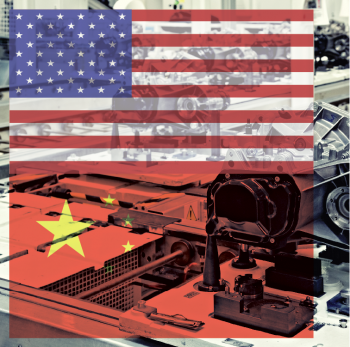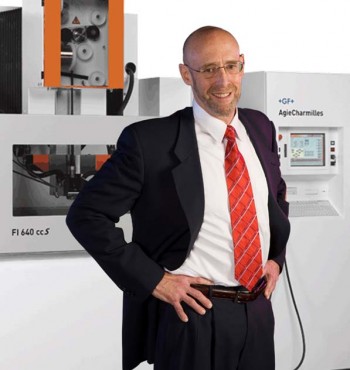
In one decade, between 1997 and 2010, the US manufacturing sector shed 5.8 million jobs. That’s roughly 33 percent of its labor force. The initial culprit was offshoring, the rapid move of US production facilities overseas, most notably to China, as US manufacturers realized that goods could be both procured and produced abroad for a fraction of the cost. The recession only furthered the decline, and the manufacturing industry as it stands today is a husk of its former self. In a decade and a half, the United States has lost a large part of what had defined it for over a century. And for many, the outlook is grim that it will ever come back.
But exciting reports have been percolating over the last year. Headlines have reported that companies are bringing some production lines back to the States. Apple has plans to produce the iMac here, and GE has reopened a few production lines at its historic Appliance Park to handle its most sensitive products. Sound bites, though, are one thing. While such news is promising, these products account for a fraction of what companies like Apple and GE produce annually. What’s really needed is an advocate that speaks the language of the manufacturer, abandoning bromides and instead offering a quantitative rationale for bringing manufacturing back to the United States.
The good news? That advocate might be Harry Moser. From his home office in Kildeer, Illinois, he is using his expertise as a seasoned manufacturing executive to lead the Reshoring Initiative, an advocacy platform that aims to educate manufacturers on the true cost of going abroad. Moser is 69 years old and works “80 hours a week” at the project. It’s an important one. If successful, he just might be the man that gives US manufacturing a second chance.
* * *

To say that Harry Moser has witnessed the dramatic wax and wane of the American manufacturing industry is an understatement. His first job was at the Singer Sewing Company’s sewing machine factory in Elizabethport, New Jersey. Moser was 14, and, for the next six years, through high school and college, he spent his summers there. This was in 1958, and Moser was following in the literal footsteps of both his father and grandfather; the latter, an immigrant from Germany, served as a foreman for Singer, while Moser’s father worked as an engineer and eventually ran one-third of the factory. Moser filled his days as a gofer: cleaning, sorting, and filing tools, as well as myriad other tasks. “I had grease under my fingernails,” he recalls, though his most fond job was taking the ferry across Newark Bay to deliver and retrieve mail from Singer’s corporate headquarters in Manhattan.
Moser’s career would take him all the way from the floor of the Singer factory to machine toolmaker GF AgieCharmilles, and the interim period offers a clear narrative for why Moser has spent his retirement fighting for the manufacturing industry. After graduating from Massachusetts Institute of Technology with a dual bachelor and master’s degree in engineering, in 1967, he went to work for GE, taking part in a manufacturing management program. The experience was formative for Moser, who was impressed by the scale of production, and he spent time at GE’s turbine factory in Schenectady, New York, before moving to the company’s nuclear projects division in San Jose, California. From here, Moser headed back to MIT, working in the university’s Industrial Liaison Office, where he forged his knack for networking as he connected with big companies around the world that paid for access to what was happening in MIT’s labs. The rest of Moser’s career serves to flesh out his already impressive credentials: technical director and director of market research for DISAMATIC, P&L responsibility at ACME Cleveland, president of Roto-Finish. In 1985, his final move brought him to Chicago, where he became president and head of North American operations of Charmilles Technology Corporation, which morphed into GF AgieCharmilles. It was during his final year there, serving as chairman emeritus in 2011, that he founded the Reshoring Initiative.
Such a career gives Moser a unique perspective on the rapid changes happening in manufacturing. In many ways, the lessons of Singer and Moser’s time there would foreshadow the dramatic upheaval experienced by US manufacturers in the late 1990s and early aughts. When it was opened in 1863, the Singer sewing factory was one of the largest structures in the world and employed a workforce of 6,000. When Moser went to work for the factory, almost a century later, it still resembled the historic factories of the late 19th century. It was in many ways an outmoded operation, seen most clearly in the fact that the factory’s machine tools were still powered by a line-shaft system, whereby belts descended from the ceiling to drive each individual machine, rather than each machine being powered by an individual motor, as they are today. The Singer factory hadn’t taken advantage of new technologies like its counterparts—factories like GE’s Appliance Park, which broke ground in 1951—that retooled the mechanization techniques developed during World World II for commercial production. “Singer undoubtedly had too much antiquated technology,” Moser says. “If they had been willing to spend, in today’s dollars, $100 million or $500 million, they could have been more modern and automated.”
Instead, in 1982, the Elizabethport facility closed, sealing forever an important chapter in US manufacturing’s development. The plight of the Singer sewing factory was similar to the plight facing US factories at the end of the last millennium, in that it was seemingly undermined by forces outside its own control. In both cases, change happened rapidly. However, China’s position as a global manufacturing leader wasn’t entirely unexpected. It’s meteoric rise emulated the success Japan found 40 years earlier. “When I was at Singer, I remember I would go to a meeting and people were bringing out parts made by Japanese companies,” Moser recalls. “I remember people laughing—Japan had been known as a toy maker. But, after the war, they were broken and poor, with a low labor rate, so they started with the cheap stuff and rapidly moved their way up.”
It was in much the same way that China slipped quietly onto the scene in the 1990s, and American companies were quick to bite. But what wasn’t clear was how much money was truly being saved, and, more importantly, what America lost in the process.
* * *
The exodus of US manufacturers to foreign soil was fueled by several things, but chief among them was a simple culprit: lower costs. Labor rates in countries like China and India are a fraction of what they are in the United States, especially in the years prior to the financial crisis of 2007–2008. Moreover, a cultural devaluation of manufacturing as a profession has seen a dearth of qualified candidates. Though man to man America’s universities tend to turn out better engineers, they don’t produce them in the quantities seen in countries like China and India. Moreover, companies like Apple are looking at these countries as new markets. In January 2013, Tim Cook, Apple’s CEO, announced that China would likely overtake the United States as its largest market as the company worked to rapidly expand its retail presence there.
However, for the average American manufacturer, the rationale for going abroad might not have been as beneficial as it initially seemed. With production taking place an ocean away, many companies have realized they had shipped knowledge off along with their manufacturing lines. “You lost two things: first off, how we make it today—sometimes you lose the design because the guy in another factory finds a design that works better,” Moser says. “Second, you’ve lost the ease of the engineer, marketing team, and factory to make [the product] better tomorrow. We’ve lost the knowledge, but we’ve also lost the efficient innovation.”
The innovation gap isn’t the only latent issue to have arisen in recent years. Others, like intellectual property risk problems and customers demanding both American-made products and faster deliveries, have made the decision to offshore a tougher sell. In such a climate, Moser’s presence is welcome. Through the Reshoring Initiative, he is giving voice to such concerns. But, more importantly, he’s also providing a resource for manufacturers to evaluate the true cost of going abroad, namely, the Total Cost of Ownership (TCO) Estimator.
Free to use, the TCO Estimator aims to approximate a more accurate cost of both offshoring and domestic sourcing, and its immediate target is the operations exec or CEO running the numbers on going abroad. “If someone only looks at the wage rate, he’d say Chinese wages are a fifth or a tenth of what they are in the US, and he’d go to China,” Moser explains. “If he only looks at the ex-works price or landed cost, even though we did the best we could in the US with innovation, the Chinese alternative is still 20 to 30 percent lower. But when they look at total cost, they might see that China is higher.”
The total cost that Moser mentions isn’t conjured as if by magic. Rather, the TCO Estimator starts with the ex-works price—the price being offered by the foreign contractor or factory for production of the actual product—then gathers information to calculate 25 other, less transparent costs, things like landed cost: the duty, freight, and shipping cost associated with getting the completed run of products back to the United States (a cost that has increased dramatically in the last decade alongside rising fuel costs). And, because it can take up to two months to get a product from the factory floor to the company’s storeroom, companies are required to carry a more extensive inventory. “In lots of cases, companies have 2–10 times as much inventory when they offshore because they receive larger shipments and don’t know when the new shipment will come in, and if it will be good or not,” Moser says.
In this same vein, a company needs to consider travel costs to visit foreign-based manufacturing facilities. If a production line is within 50 miles of a company’s research and design team, any kinks with a manufacturing defect can be knocked out with a half-day trip. However, if something goes wrong with a production line in China, suddenly that same team has to hop on a red-eye flight. Further, if a faulty product shows up in a shipment, a company is faced with a stark choice: hope all the parts in subsequent shipments—many of them already en route, tucked away in stacks of shipping containers in the middle of the ocean—are actually made correctly, or air freight a new run at great expense. Then, because of the lag in shipping, there’s the opportunity cost of offshoring. “If all of a sudden everyone wants a stainless-steel finish instead of copper, here in the US you might make and ship them in about a week,” Moser says. “In China, it might be 8–10 weeks, and you lose some orders because you can’t deliver.”
These are the costs that are most easily estimated. Moser also encourages companies to consider the risk of natural disasters that might knock out one leg of the company’s supply chain. “If your supply chain has too many legs in it—you have pieces coming in from 100 different countries—and if any one of them has a revolution or a volcano or tsunami, then you might be screwed,” he explains. “But if you change all that and get everything within 50 miles of a factory here, then either everything’s good, and you can get all the parts and make your product, or everybody’s wiped out. And if wiping one of them out means you can’t make the part, you might as well have 1/100th the chance that all of them wipe out.”
Moser is more than willing to admit a company might use the TCO Estimator and still conclude that going abroad is a better option. The important thing is that the evaluation is better informed, which is a major reason why the Reshoring Initiative is doing a lot more than sounding a trumpet. Unlike a lot of think tanks and advocacy groups—the organizations that put out white papers, provide analysis, and give speeches—Moser’s aim is to provide an actual tool. The TCO Estimator, free on the Reshoring Initiative’s website, is one among several of these. The organization also provides an in-depth
library cataloguing all the major news articles on reshoring coming out each day. This is then searchable, so if a company wants to get information on what others in its industry have reshored from China and why, it’s able to log on and limit the search to exactly what it’s looking for.
In addition, Moser is starting to build a stable retinue of case studies—examples of real companies bringing manufacturing lines back to the States. These are easily viewable as PDF abstracts, offering a quick summary of what was brought back from where. “Companies can use the library and the case studies to see what others are reshoring,” Moser explains. “So, a foundry salesman can see what GM or Ford has done; he can then go to the other one and say, ‘If it made sense for them, it will probably make sense for you,’ and provide a quote.”
These services are only the start of what Moser hopes to achieve. Currently, he’s taking the TCO Estimator to the next level with the help of a group of MBAs at Ohio State University. Whereas the current model calculates the microeconomic impact of a company’s decision to offshore—those factors that pertain solely to the firm itself—the MBAs have assembled the first draft of an externalities estimator. That is, it will help tabulate the macroeconomic impact of offshoring: how it will impact the domestic economy. With this information in tow, firms will also be able to assess the governmental and societal impact of their decision.
* * *
Moser sees himself as the Little Dutch Boy—that iconic figure with his finger plugging the hole in the dike that separates Holland from the roiling waters of the North Sea—except instead of Holland it’s the United States facing off against the crushing waves of offshoring. It’s a fitting analogy, and Moser often closes his speeches by conjuring up the image. “In this simile, instead of Holland, this is the US; instead of the North Sea, this is offshoring, and the Dutch Boy is Harry when I had hair,” he says, usually garnering a laugh from the audience. “And you, the audience, are the village elders. If you go out and say it’s good that Harry is having so much fun in retirement, good luck Harry, then offshoring will continue and your kids won’t have jobs. But if you take this tool and go back and use it at your companies to make better decisions, or convince your customers to make better decisions, then we’ll push back offshoring. The US will be saved, and Harry won’t get crushed.”
It’s a compelling argument, and people have been listening. Industry Week inducted Moser into its hall of fame, and, in January 2012, Moser attended the White House to present his ideas to President Obama. And, earlier this year, Moser won an audience-scored debate hosted by the Economist’s website on reshoring and a company’s duty to country, signaling a shift away from mindless globalization. Despite such success, Moser is far from taking a breather. His next aim is to expand the Reshoring Initiative’s reach and hopefully attain national visibility on par with that of the Boston Consulting Group, whose high visibility has played a key role in documenting the reshoring trend. To be sure, Moser has his work cut out for him. Though he has assistance with a few aspects of the Reshoring Initiative’s website, Moser is essentially the man behind the curtain keeping everything together. He’s officially “retired,” though his workweek stretches to 80 hours. Even with the bustle, Moser can’t see spending his retirement any other way. “It’s wonderful fun,” he says. “Everywhere I go, everyone is delighted.”
There’s also a legacy that Moser is taking full circle, one that started almost a century ago on the factory floor of the Singer sewing machine factory in Elizabethport, New Jersey. It is the legacy of a family, one committed to the idea that America was only as good as what it could make with its own hands. “We’re not do-gooders, we’re not public servants in the employee sense, but the family always was very responsible,” Moser says. “When I tell my sister in New Jersey about what we are achieving, she says, ‘Dad is watching you from above, and he is
smiling.’”
How fitting that Moser, who has always been in the business of making things, is the one taking up the standard for American manufacturing. How fitting that the Reshoring Initiative is the most important product he’s ever produced. How fitting that one man is willing to go to such lengths for a greater good. It’s a very American story, and it’s about time we stopped to listen. Then, if we’re smart, we’ll act.

